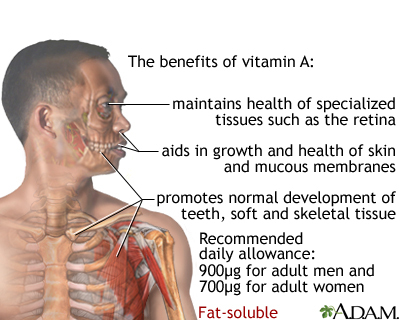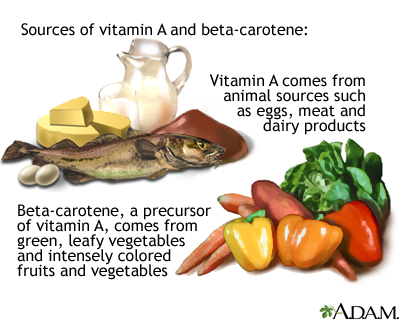Definition
Vitamin A is a fat-soluble vitamin that is stored in the liver.
There are two types of vitamin A that are found in the diet.
- Preformed vitamin A is found in animal products such as meat, fish, poultry, and dairy foods.
- Precursors to vitamin A, also known as provitamin A, are found in plant-based foods such as fruits and vegetables. The most common type of pro-vitamin A is beta-carotene.
Vitamin A is also available in dietary supplements. It most often comes in the form of retinyl acetate or retinyl palmitate (preformed vitamin A), beta-carotene (provitamin A) or a combination of preformed and provitamin A.
Alternative Names
Retinol; Retinal; Retinoic acid; Carotenoids
Function
Vitamin A helps form and maintain healthy teeth, skeletal and soft tissue, mucus membranes, and skin. It is also known as retinol because it produces the pigments in the retina of the eye.
Vitamin A promotes good eyesight, especially in low light. It also has a role in healthy pregnancy and breastfeeding.
Vitamin A is found in two forms in food:
- Retinol: Preformed retinol is an active form of vitamin A. It is found in animal liver, whole milk, and some fortified foods.
- Provitamin A carotenoids: Carotenoids are plant pigments (dyes). Once ingested, the body converts these compounds into vitamin A. There are more than 500 known carotenoids. One such carotenoid is beta-carotene.
Beta-carotene is an antioxidant. Antioxidants protect cells from damage caused by substances called free radicals.
Free radicals are believed to:
- Contribute to certain long-term diseases
- Play a role in aging
Eating food sources of beta-carotene may reduce the risk for cancer.
Beta-carotene supplements do not seem to reduce cancer risk.
Food Sources
Vitamin A is found in both plant and animal foods.
Foods with the highest levels of vitamin A include:
- Beef liver and other organ meats (these are high in saturated fat and cholesterol, so limit the amount you eat)
- Some types of fish such as herring and salmon and cod fish oil
- Eggs
- Dairy products such as cheese and fortified milk (choose non-fat and low-fat dairy options)
- Fortified breakfast cereals
- Orange and yellow vegetables and fruits, such as carrots, sweet potatoes, mangos, and cantaloupe
- Broccoli, spinach, and most dark green, leafy vegetables
The deeper or brighter the color of a fruit or vegetable, the higher the amount of carotenoids. Vegetable sources of beta-carotene are fat- and cholesterol-free. Their absorption is improved if these sources are eaten with a small amount of fat.
Side Effects
DEFICIENCY:
If you do not get enough vitamin A, you have more risk of eye problems such as:
- Reversible night blindness
- Non-reversible corneal damage known as xerophthalmia
Lack of vitamin A can also lead to hyperkeratosis or dry, scaly skin.
HIGH INTAKE:
If you get too much vitamin A, you can become sick.
- Large doses of vitamin A in pregnant women can also cause birth defects.
- Acute vitamin A poisoning most often occurs when an adult takes several hundred thousand IUs of vitamin A.
- Chronic vitamin A poisoning may occur in adults who regularly take more than 25,000 IU a day.
Babies and children are more sensitive to vitamin A. They can become sick after taking smaller doses of vitamin A or vitamin A-containing products such as retinol (found in skin creams).
Large amounts of beta-carotene will not make you sick. However, high amounts of beta-carotene can turn the skin yellow or orange. The skin color will return to normal once you reduce your intake of beta-carotene.
Recommendations
Recommendations for vitamin A, as well as other nutrients, are provided in the Dietary Reference Intakes (DRIs) developed by the Food and Nutrition Board at the National Academies of Sciences, Engineering, and Medicine. DRI is a term for a set of reference intakes that are used to plan and assess the nutrient intakes of healthy people. These values, which vary by age and sex, include:
Recommended Dietary Allowance (RDA): The average daily level of intake that is enough to meet the nutrient needs of nearly all (97% to 98%) healthy people. An RDA is an intake level based on scientific research evidence.
Adequate Intake (AI): This level is established when there is not enough scientific research evidence to develop an RDA. It is set at a level that is thought to ensure enough nutrition.
Dietary reference intakes for vitamin A:
Infants (AI)
- 0 to 6 months: 400 micrograms per day (mcg/day)
- 7 to 12 months: 500 mcg/day
The Recommended Dietary Allowance (RDA) for vitamins is how much of each vitamin most people should get each day. The RDA for vitamins may be used as goals for each person.
Children (RDA)
- 1 to 3 years: 300 mcg/day
- 4 to 8 years: 400 mcg/day
- 9 to 13 years: 600 mcg/day
Adolescents and adults (RDA)
- Males age 14 and older: 900 mcg/day
- Females age 14 and older: 700 mcg/day (for females aged 19 to 50, 770 mcg/day during pregnancy and 1,300 mcg/day during breastfeeding)
The best way to get the daily requirement of important vitamins is to eat a wide variety of fruits, vegetables, fortified dairy foods, legumes (dried beans), lentils, and whole grains.
References
Markell M, Siddiqi HA. Vitamins and trace elements. In: McPherson RA, Pincus MR, eds. Henry's Clinical Diagnosis and Management by Laboratory Methods. 24th ed. Philadelphia, PA: Elsevier; 2022:chap 27.
Mason JB, Booth SL. Vitamins, trace minerals, and other micronutrients. In: Goldman L, Schafer AI, eds. Goldman-Cecil Medicine. 26th ed. Philadelphia, PA: Elsevier; 2020:chap 205.
National Institutes of Health website. Vitamin A: fact sheet for health professionals. ods.od.nih.gov/factsheets/VitaminA-HealthProfessional/. Updated March 26, 2021. Accessed April 30, 2021.
Ross CA. Vitamin A deficiencies and excess. In: Kliegman RM, St. Geme JW, Blum NJ, Shah SS, Tasker RC, Wilson KM, eds. Nelson Textbook of Pediatrics. 21st ed. Philadelphia, PA: Elsevier; 2020:chap 61.



